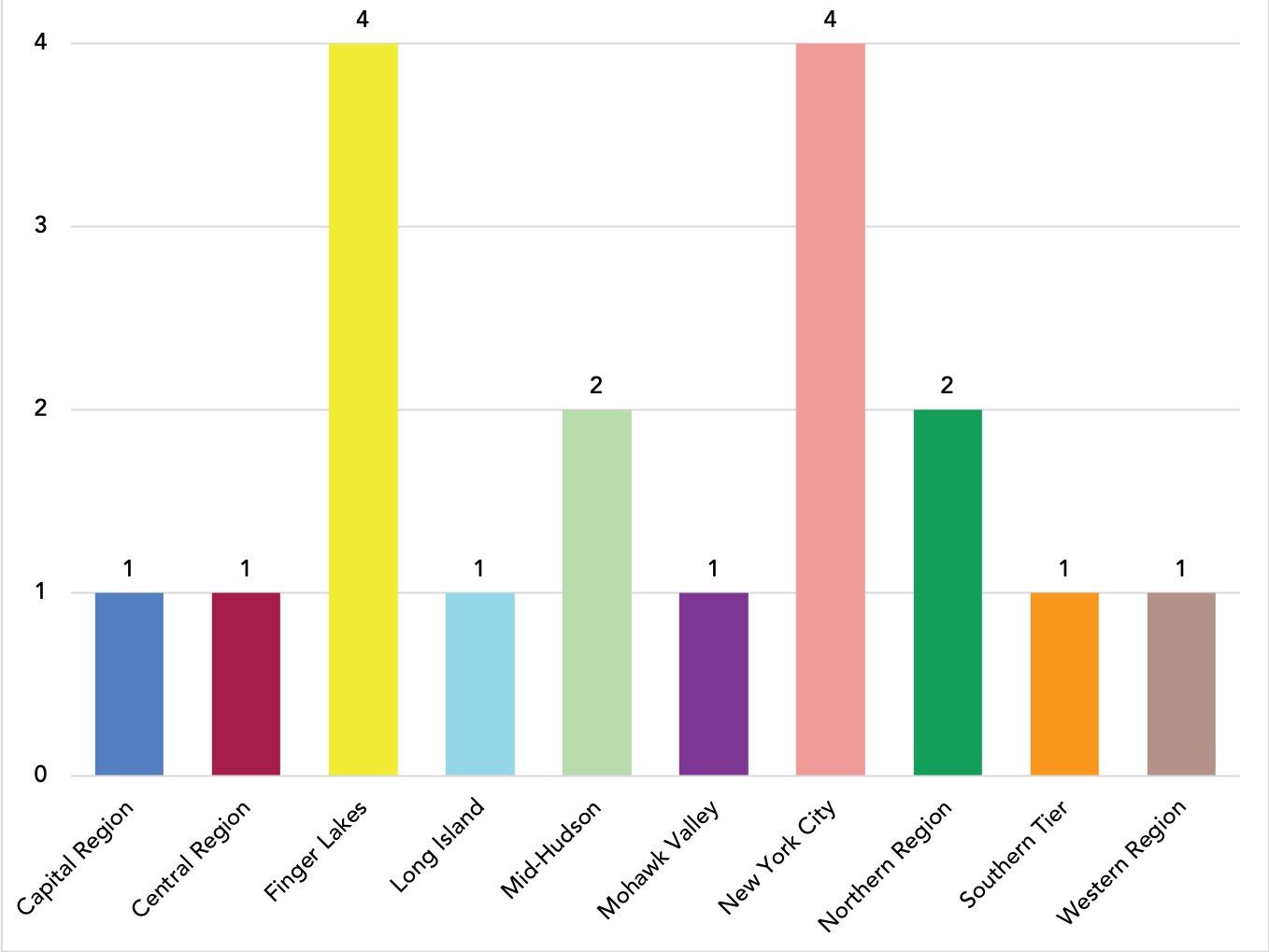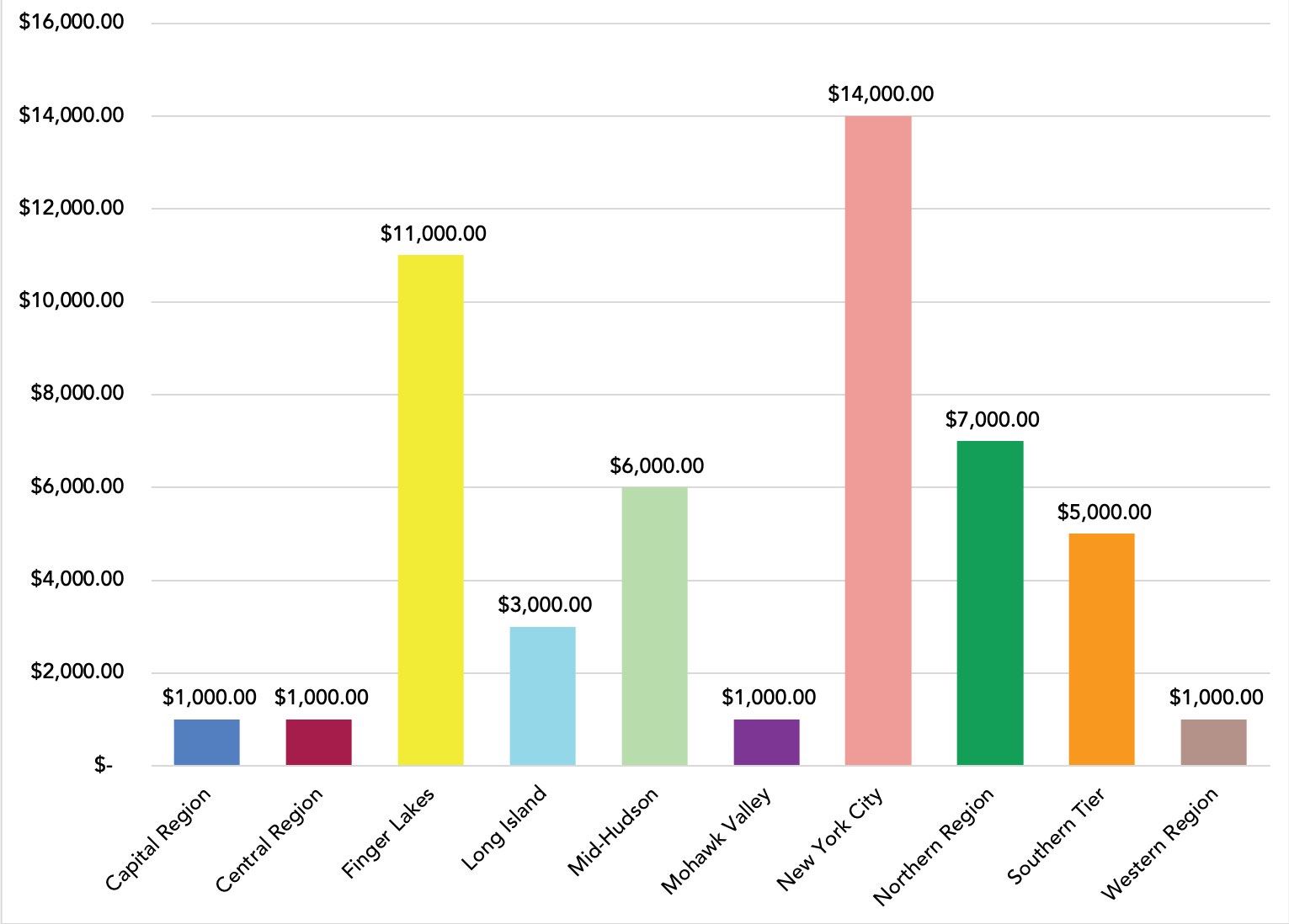In response to the COVID-19 pandemic the William G. Pomeroy Foundation and the Museum Association of New York formed a new partnership and created the Pomeroy Fund for NYS History to support the state’s smallest history-related organizations. In three grant rounds, the Pomeroy Fund for NYS History funded 69 organizations across New York State $147,808.72.
“MANY was able to quickly assess the urgent needs of the history community and was an invaluable resource during this difficult time,” said Deryn Pomery, Director of Strategic Initiatives of the William G. Pomeroy Foundation. “We were impressed with how they mobilized and advocated for the museum community and assisted us in the grant review process.”
Grant applications were reviewed by a panel that included MANY Board, MANY staff, and Pomeroy Foundation staff. Eligible organizations did not need to be members of MANY to apply.
Total Amount of Funds Dispersed by Grant Round

Total Number of Grants by REDC

Total Amount of Funds by REDC

Round 1
In Round 1, 31 organizations with budget sizes of $100,000 or less were awarded grants ranging between $1,000 and $2,000, totalling $50,808.72. More than 170 organizations applied totaling almost $300,000 in requests. Funds were used to purchase computer hardware or software, gain internet access or expand bandwidth, pay for utilities, and secure facilities and collections.
The Fulton County Historical Society (FCHS), was awarded $1,558. Since closure at the start of the coronavirus pandemic, FCHS began to think more carefully and creatively about virtual programming, experimenting with online programming, and social media use to improve their digital presence and expand their reach. FCHS used the funds to purchase a laptop computer and to update the museums’ hardware and software in order to develop more online programming.
Round 1 Grantees
Anderson Falls Heritage Society
Black Rock Historical Society
Brentwood Historical Society
Broome County Historical Society
Clinton County Historical Association
Darwin R. Barker Library and Museum Association
Fulton County Historical Society
Gates Historical Society
Hastings Historical Society
Historic Red Hook
Historical Society of the Tonawandas, Inc.
Historical Society of Woodstock
Howland Stone Store Museum
Interlaken Historical Society
Java Historical Society
Lodi Historical Society
Macedon Historical Society
Mastic Peninsula Historical Society
Montgomery County Historical Society
National Bottle Museum
Nunda Historical Society
Oswego County Historical Society
Peekskill Museum, Inc.
Preservation Association of the Southern Tier
Schoharie Colonial Heritage Association
The Warsaw Historical Society and Gates House Museum
Town of Madison Historical Society
Town of New Scotland Historical Association
West Bloomfield Historical Society
Wappingers Historical Society Inc.
Yaphank Historical Society
Round One of Grants by REDC

Round One Grant Amount by REDC

Round Two
The Pomeroy Fund expanded eligibility in Round Two to organizations with an annual budget size of $150,000 or less but organizations needed to be open to the public no fewer than 250 hours, including program delivery hours. Organizations that received funding in the 1st round were not eligible. Grants were made on a sliding scale between $1,000 and $5,000 based on budget size. The Pomeroy Fund received 112 applications requesting $367,000. 18 organizations were awarded a total of $50,000.
Applicants shared details regarding their public programming both onsite and virtual, identified the wide range of audiences served, and the ways in which they engage their communities through unique and distinct partnerships.
The Livingston County Historical Society used its $4,000 grant to support general operating expenses including salary for the only paid staff person. This staff person was essential in creating a safe reopening plan for the museum.
The National Abolition Hall of Fame and Museum (NAHOF), an all volunteer organization, used its $1,000 grant to cover the cost of internet services and its email service to its members and supporters. The grant helped the NAHOF maintain and expand their virtual reach to their local, state, and national supporters and promoted the organization to develop more online programs.
Based on a follow up survey administered by MANY that assessed rounds one and two, when asked to specifically name items purchased with grant funding, 35% of awarded organizations mentioned computers and related hardware such as printers. 22% mentioned software like Microsoft Office or Past Perfect. Others mentioned using funds for general operating expenses like utilities and staff salaries. When asked what impact the grant had on staff, organization, and/or community, 34% mentioned increased community engagement and connecting with their community virtually, 20% mentioned increased access to collections through digitization, and 10% mentioned building security.
Round Two Grantees
Beacon Historical Society
City Island Historical Society
Constable Hall Association, Inc.
Dyckman Farmhouse Museum Alliance
Friends of City Reliquary, Inc.
Friends of Mills at Staatsburgh
Greece Historical Society
Livingston County Historical Society
National Abolition Hall of Fame and Museum
North Country Underground Railroad Historical Association
Phelps Mansion Museum
Sodus Bay Historical Society
The Coney Island History Project Inc.
The Historical Society of the Town of Chester
The Lake Ronkonkoma Historical Society
Waterville Historical Society
Webster Museum and Historical Society
West Seneca Historical Society and Museum
Round Two Number of Grants by REDC

Round Two Grant Amounts by REDC

Round Three
In July, a 3rd round of funding was announced to provide an additional $50,000 in grants in a continuation of rapid response to history-related organizations. 21 organizations were selected to raise up to $6,000 for a 2:1 match by the Pomeroy Fund. Each submitted proposals that outlined plans for reopening, identifying multiple funding sources, creative ways to grow donors, and collaborative partnerships to find new avenues of support.
These participating organizations had until October 1 to raise funds in order to receive the match.
The Irish American Heritage Museum engaged their membership through their newsletter and social media channels. Their Board took an active role in raising the matching funds and was challenged to raise $1,500, half of the needed funds. The museum had 40 donors total and raised $6,355, $355 more than goal.
In Western NY, the Steel Plant Museum had 65 individual donors raising $5,013. The grant helped the museum stay open, with funding dedicated to monthly rent and curator’s salary.
In a follow up survey, 30% said they used the funds to support operating expenses and staff salaries and 30% purchased and installed COVID safety measures including sanitation stations, wipes, gloves, masks, safety signage, plexi dividers, touchless amenities for bathrooms, and air filter upgrades.
Round Three Grantees
Amagansett Life-Saving and Coast Guard Station Society
Bundy Museum of History and Art
Canal Society of New York State, Inc.
Chenango County Historical Society & Museum
Cincinnatus Area Heritage Society
Cobblestone Society
Douglaston and Little Neck Historical Society
East Bloomfield Historical Society
Freeport Historical Society
Gates Historical Society
Half-Shire Historical Society
Historical Society of Newburgh Bay and the Highlands
Irish American Heritage Museum
John Brown Lives
Robert Jenkins House and Museum
Seneca Museum of Waterways and Industry
Slate Valley Museum Foundation
Sodus Bay Historical Society
The Matilda Joslyn Gage Foundation
The Steel Plant Museum of Western New York
Round Three Number of Grants by REDC

Round Three Grant Amount by REDC

Throughout each grant round, the high response by the history-related organizations in New York State demonstrates how deeply museums have been affected by the pandemic and how much support will be needed moving forward. MANY thanks the Pomeroy Foundation for their rapid response to aid our historical societies and history museums.
“We are very proud of our work with MANY, and through our partnership, were able to provide much needed emergency funding for 69 small history-related organizations struggling during the pandemic,” said Deryn Pomeroy.
